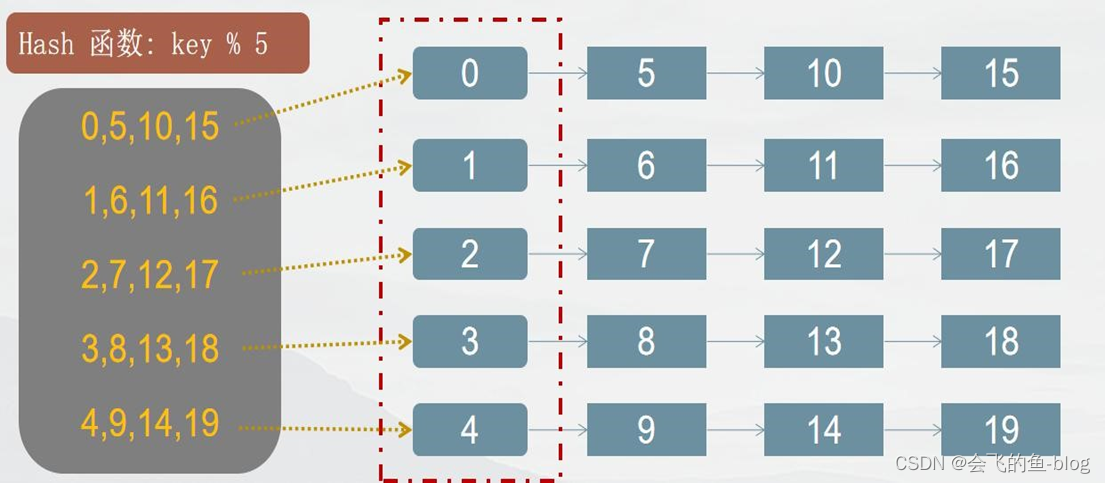哈希表的故事导入
故事情节
为了提高开发团队精神,缓解工作压力,某 IT 公司组织开发团队的 12 位男同事和测试团队 的 12 位女同事开展真人 CS 4vs4 野战联谊!面对性感的女同事,男同事们个个摩拳擦掌,跃跃欲 试!
野战活动那天,根据男女搭配,干活不累的原则,带队的专业教练让男同事站成一排,女同 事站成一排,然后要求从女生这排开始从 1 开始报数,每个报数的队员都要记住自己的编号: 1, 2, 3,4。。。。。。林子里响起了百灵鸟般的报数声!

报数时,教练发给每人一个白色的臂章贴在肩膀上,每个臂章上写着报数人自己报过的编号!
当所有人都报完数后,教练发出命令将 24 人均分成 6 个组!
编号除 6 能整除的为第一组: 6 12 18 24
编号除 6 余数为 1 的为第二组: 1 7 13 19
编号除 6 余数为 2 的为第三组: 2 8 14 20
编号除 6 余数为 3 的为第四组: 3 9 15 21
编号除 6 余数为 4 的为第五组: 4 10 16 22
编号除 6 余数为 5 的为第六组: 5 11 17 23
通过这种编号方式划分队列,无论队员归队,还是裁判确89认79队43员8身40份1,11都1非常方便,此后林 子里传来隆隆的笑声和枪炮声! 这种编号的方式就是高效的散列,我们俗称“哈希”! 以上过程是通过把关键码值 key(编号)映射到表中一个位置(数组的下标)来访问记录,以加 快查找的速度。这个映射函数叫做散列函数,存放记录的数组叫做散列表。
哈希表的原理精讲
哈希表 - 散列表,它是基于快速存取的角度设计的,也是一种典型的“空间换时间”的做法
键(key): 组员的编号 如, 1 、 5 、 19 。 。 。
值(value): 组员的其它信息(包含 性别、年龄和战斗力等)
索引: 数组的下标(0,1,2,3,4) ,用以快速定位和检索数据
哈希桶: 保存索引的数组(链表或数组),数组成员为每一个索引值相同的多个元素
哈希函数: 将组员编号映射到索引上,采用求余法 ,如: 组员编号 19

哈希链表的算法实现
哈希链表数据结构的定义
#define DEFAULT_SIZE 16
typedef struct _ListNode
{
struct _ListNode *next;
int key;
void *data;
}ListNode;
typedef ListNode *List;
typedef ListNode *Element;
typedef struct _HashTable
{
int TableSize;
List *Thelists;
}HashTable;哈希函数
/*根据 key 计算索引,定位 Hash 桶的位置*/
int Hash(int key, int TableSize)
{
return (key%TableSize);
}
哈希链表初始化
/*初始化哈希表*/
HashTable *InitHash(int TableSize)
{
int i = 0;
HashTable *hTable = NULL;
if (TableSize <= 0) {
TableSize = DEFAULT_SIZE;
}
hTable = (HashTable *)malloc(sizeof(HashTable));
if (NULL == hTable)
{
printf("HashTable malloc error.\n");
return NULL;
}
hTable->TableSize = TableSize;
//为 Hash 桶分配内存空间,其为一个指针数组
hTable->Thelists = (List *)malloc(sizeof(List)*TableSize);
if (NULL == hTable->Thelists)
{
printf("HashTable malloc error\n");
free(hTable);
return NULL;
}
//为 Hash 桶对应的指针数组初始化链表节点
for (i = 0; i < TableSize; i++)
{
hTable->Thelists[i] = (ListNode *)malloc(sizeof(ListNode));
if (NULL == hTable->Thelists[i])
{
printf("HashTable malloc error\n");
free(hTable->Thelists);
free(hTable);
return NULL;
}
else
{
memset(hTable->Thelists[i], 0, sizeof(ListNode));
}
}
return hTable;
}
哈希链表插入元素
/*哈希表插入元素,元素为键值对*/
void Insert(HashTable *HashTable, int key, void *value )
{
Element e=NULL, tmp=NULL;
List L=NULL;
e = Find(HashTable, key);
if (NULL == e)
{
tmp = (Element)malloc(sizeof(ListNode));
if (NULL == tmp)
{
printf("malloc error\n");
return;
}
L = HashTable->Thelists[Hash(key, HashTable->TableSize)];
tmp->data = value;
tmp->key = key;
tmp->next = L->next;
L->next = tmp;
}
else
printf("the key already exist\n");
}哈希链表查找元素
/*从哈希表中根据键值查找元素*/
Element Find(HashTable *HashTable, int key)
{
int i = 0;
List L = NULL;
Element e = NULL;
i = Hash(key, HashTable->TableSize);
L = HashTable->Thelists[i];
e = L->next;
while (e != NULL && e->key != key)
e = e->next;
return e;
}
哈希链表删除元素
/*哈希表删除元素,元素为键值对*/
void Delete(HashTable *HashTable, int key )
{
Element e=NULL, last=NULL;
List L=NULL;
int i = Hash(key, HashTable->TableSize);
L = HashTable->Thelists[i];
last = L;
e = L->next;
while (e != NULL && e->key != key)
{
last = e;
e = e->next;
}
if(e)
{ //如果键值对存在
last->next = e->next;
delete(e);
}
}源码实现:
hash_table.h
#pragma
#define DEFAULT_SIZE 16
typedef struct _ListNode
{
int key;
void* data;
struct _ListNode* next;
}ListNode;
typedef ListNode* List;
typedef ListNode* Element;
typedef struct _HashTable
{
int TableSize;
List* Thelists;
}HashTable;hash_table.cpp
#include <stdio.h>
#include <stdlib.h>
#include <string.h>
#include "hash_table.h"
int Hash(int key, int TableSize)
{
return (key % TableSize);
}
//初始化哈希表
HashTable* InitHash(int TableSize)
{
HashTable* hTable = NULL;
int i = 0;
hTable = (HashTable*)malloc(sizeof(HashTable));
if (hTable == NULL)
{
printf("分配哈希表失败!");
return NULL;
}
if (TableSize < 0)
{
TableSize = DEFAULT_SIZE;
}
hTable->TableSize = TableSize;
hTable->Thelists = (List *)malloc(sizeof(List) * TableSize);
if (hTable->Thelists == NULL)
{
printf("分配失败!");
free(hTable);
return NULL;
}
for (int i = 0; i < TableSize; i++)
{
//if(sizeof(ListNode)<sizeof(List)*TableSize)
hTable->Thelists[i] = (ListNode*)malloc(sizeof(ListNode));
if (hTable->Thelists[i] == NULL)
{
printf("分配失败!");
free(hTable->Thelists);
free(hTable);
return NULL;
}
else
{
memset(hTable->Thelists[i], 0, sizeof(ListNode));
}
}
return hTable;
}
//从哈希表中根据键值查找元素
Element Find(HashTable* HashTable, int key)
{
int i = Hash(key, HashTable->TableSize);
List L = NULL;
L= HashTable->Thelists[i];
Element e = NULL;
e = L->next;
while (e != NULL && e->key != key)
{
e = e->next;
}
return e;
}
void Insert(HashTable* HashTable, int key, void* value)
{
int i = 0;
i = Hash(key, HashTable->TableSize);
List L = NULL;
L = HashTable->Thelists[i];
Element tmp = Find(HashTable, key);
if (!tmp)
{
Element e = NULL;
e = (Element)malloc(sizeof(ListNode));
if (!e)
{
printf("分配失败!");
return;
}
e->data = value;
e->key = key;
e->next = L->next;
L->next = e;
}
else
{
printf("表中有重复键值");
}
}
void Delete(HashTable* HashTable, int key)
{
int i = Hash(key, HashTable->TableSize);
List L = NULL;
L = HashTable->Thelists[i];
Element next = NULL, cur = NULL;
next = L->next;
cur = L;
while (next != NULL && next->key != key)
{
cur = next;
next = next->next;
}
if (next)
{
cur->next = next->next;
delete(next);
}
}
void* Retrieve(Element e)
{
return e ? e->data : NULL;
}
void Destory(HashTable* HashTable)
{
int i = 0;
List L = NULL;
Element cur = NULL, next = NULL;
for (int i = 0; i < HashTable->TableSize; i++)
{
L = HashTable->Thelists[i];
cur = L->next;
while (cur != NULL)
{
next = cur->next;
free(cur);
cur = next;
}
free(L);
}
free(HashTable->Thelists);
free(HashTable);
}
int main(void)
{
char *elems[] = { "翠花","小芳","老师" };
int i = 0;
HashTable* HashTable;
HashTable = InitHash(31);
Insert(HashTable, 1, elems[0]);
Insert(HashTable, 2, elems[1]);
Insert(HashTable, 3, elems[2]);
Delete(HashTable, 1);
for (i = 0; i < 4; i++)
{
Element e = Find(HashTable, i);
if (e)
{
printf("%s\n", (const char*)Retrieve(e));
}
else
{
printf("Not found [key:%d]\n", i);
}
}
system("pause");
return 0;
}






















 4091
4091











 被折叠的 条评论
为什么被折叠?
被折叠的 条评论
为什么被折叠?










